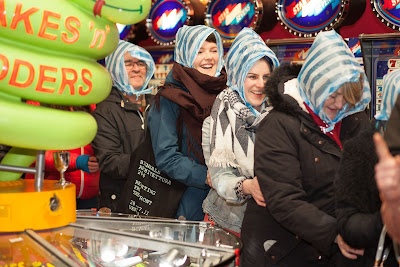Artists in residence GÂST (Laura Mahony and Dale Fearnley) reflect on their introduction to Berwick-upon-Tweed and its significant venues.
Michael Stewart, Champion of The Ultimate Berwick-upon-Tweed Pub Quiz, has many stories about three of the town’s most prominent social venues: The Brown Bear pub, Spittal Beach Amusement Arcade, and Shielfield Park, home of Berwick Rangers FC. They have all witnessed action and emotion, jovial chants of celebration, and heartfelt anguish. All of these places are important to a very local community; while also having wider economic and social significance, highlighting the challenges of modern day place identity in rural areas. They were all to prove important in our exploration of the town.
Within weeks of our arrival in Berwick, we had attended a plethora of social gatherings, from the Holy Trinity Church’s potluck harvest supper, to the Bear Claw Microbrewery’s open tap day, in a bid to get to know the residents. Our first few days were spent venturing into the wider rural regions of Northumberland. But we quickly decided to focus our efforts within our immediate locality, walking round the Elizabethan walls, joining the library, and ambling across to Spittal Beach.
An angular, single storey, red and yellow “Venetian” pavilion stands on the promenade, complete with hanging awnings boasting “Ice-cream, Candy Floss, and Family Amusements,” as it overlooks the River Tweed greeting the North Sea. Inside, the ornate, silver and gold glittered ceiling contrasts with the retro arcade machines and hand written Keep Out signs. A white haired, flat-capped Yorkshire man, in a heavy raincoat, was working, changing notes for coppers, while his wife, the only other punter, entertained herself on the slot machines. He introduced himself as Don, and spoke to us at great length about the history of the building, once a fine dance hall, now the only arcade in Berwick, and how much he loves working there. It is a place where he can socialize with masses of visitors in the summer; a place where whole generations of families come to play hook-a-duck and penny-push, searching feverishly for spare coins in the hopes of winning plastic key-rings. We were instantly taken with the tinkling noises, the flashing lights, the distant smell of salt and vinegar on freshly fried chips and spent an afternoon there, drinking it in, playing the penny-pusher games and recording the wonderful kitsch splendour of the arcade on our new Instagram account. Bobbo, the dancing mechanical clown, was a particular hit with our followers.
It is difficult to describe how we decided that these venues were going to be what encapsulated our residency, other than we felt the emotional weight of them. Alain De Botton says in The Architecture of Happiness:
“Belief in the significance of architecture is premised on the notion that we are, for better or worse, different people in different places – and on the conviction that it is architecture’s task to render vivid to us who we might ideally be.”
The arcade may not be an architectural wonder, it is used and worn and cracked, but it is clearly adored by the community. We felt like different people in the arcade, able to laugh out loud at our losses on the roulette wheel, able to chat casually to Don, able to press pause for a while in an otherwise fast paced society.
Shielfield Park was another site that caught our interest, after we took the Lowry trail and discovered The Stanks. This grassy area was used for many years as a football pitch, and more recently charity football matches. We were very taken by the name, which reminded us of some previous work associated with dialect, language and sport. Skulking around the empty site, loitering in the car park between the home pub the Black and Gold and the main building itself, peering in through the large metal gates leading to the stadium, we realized the outskirts of the pitch are shared with the Berwick Bandits speedway course. It wasn’t until the following weekend we attended a match, Berwick V Cowdenbeath. In a stadium that was perhaps half full, we quickly realized we were on the slightly more conventional side of the pitch. Across from us, in what looked like a corrugated metal shed, was where the real action was happening. The Ducket, erected in tiered concrete, provides an area for spectators to stand and jump or chant profanities and angrily kick the enclosure in a glorious display of synchronized emotions.
Many of our walks, long or short, would land us in the pub for a rewarding pint. A good pub could put anyone at ease and open to share conversation on personal and current affairs, in an environment where one ‘becomes the participator, rather than the spectator.’ The largest and oldest pub is The Brown Bear, with its gold Victorian ironwork, luscious heavy red drapes and chandelier – an ideal vantage point for observing life in Berwick.

